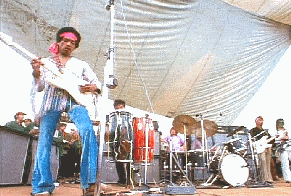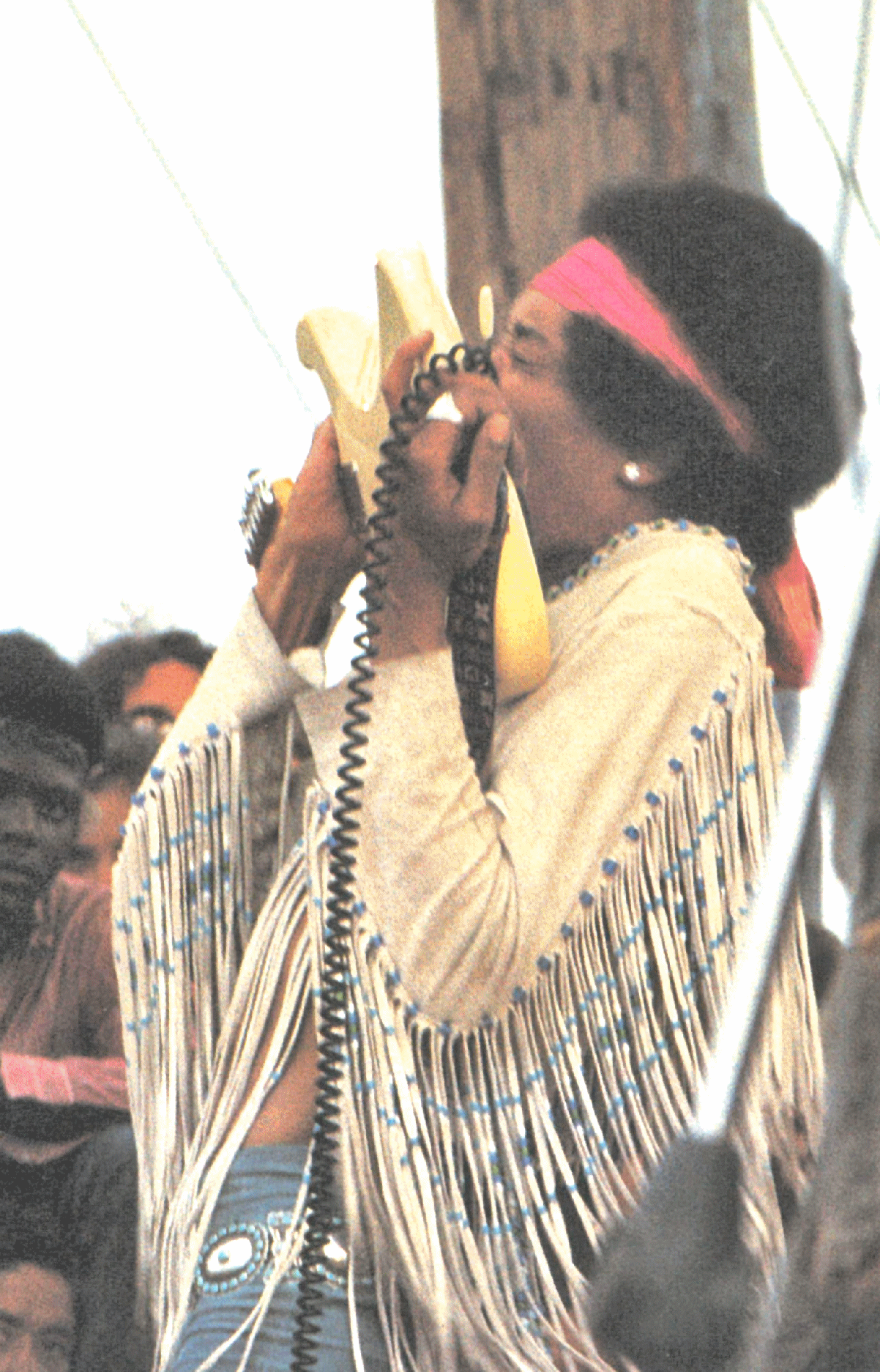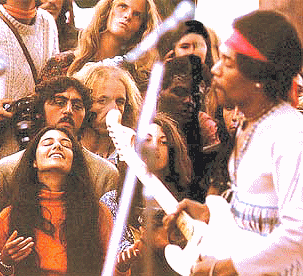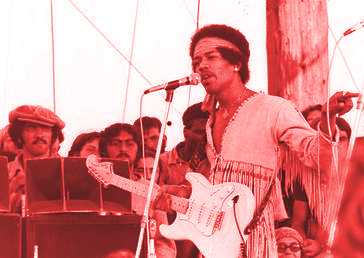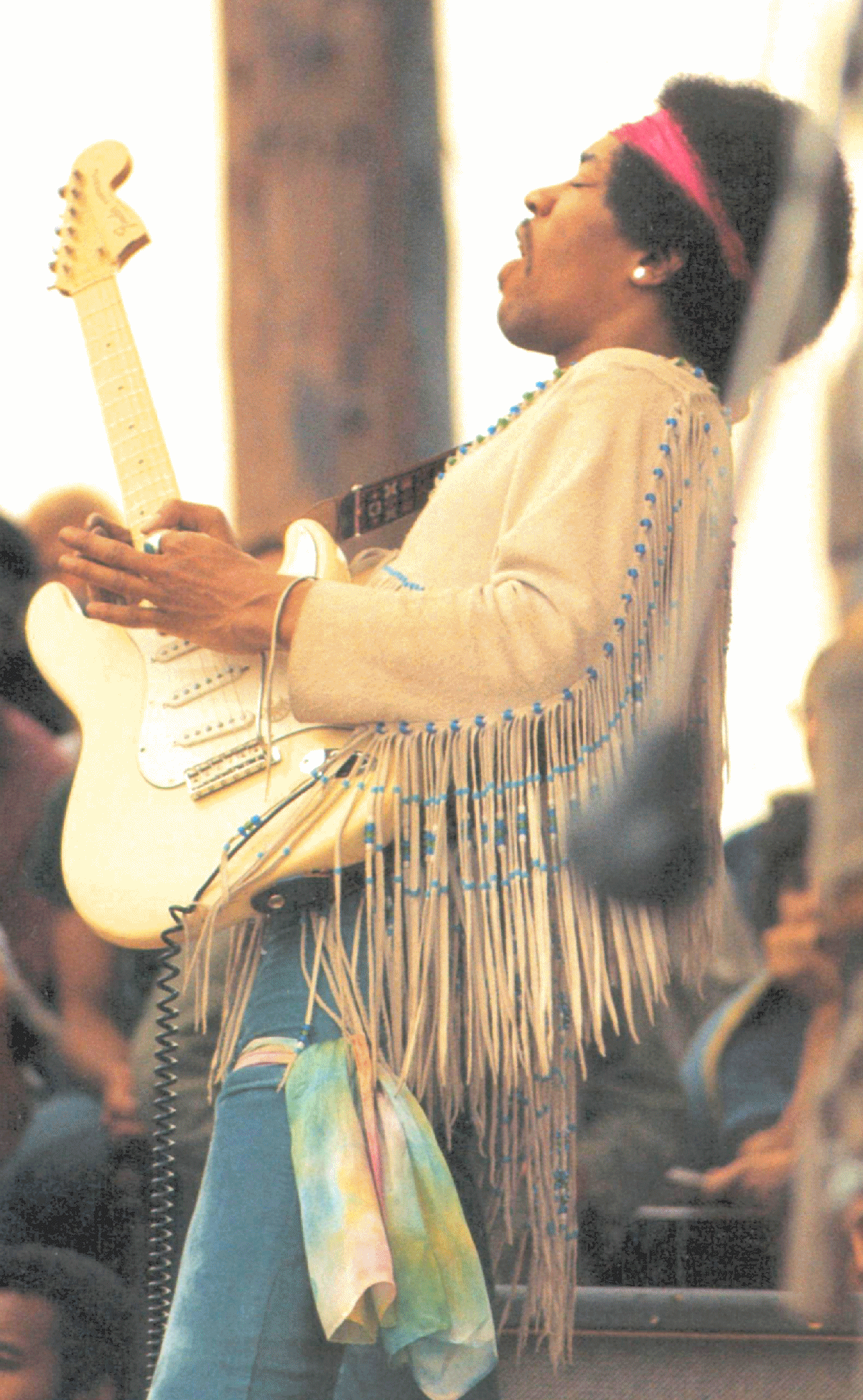Dew had evaporated and standing rainwater streamed skyward. As if through a waking dream, Jimi strode out in his most-Gypsy threads. A ring of children on the mount believed he was Jesus with a guitar. A diagonal crane in the background symbolizes the reconstruction.
Freeks in the muddy field remained solely for this moment. It'd been seven weeks since Jimi's last Sky Church set. Under a tarpaulin sailing at full-mast, he takes the helm like a pirate master of the High Seas. His Strat's maple headstock wood looks as if it'd been split off a nearby tree. Jimi signals his extended rhythm section to christen the assembly in Fire. Sound waves careen off trees and bounce over the hills in an ever-expanding radius.
Keeping the conga beat is Jerry Velez, brother of singer Martha Velez. Also on percussion is Juma Sultan. "There's a place in Woodstock called the Village Green," Juma recalls, "it's right in the center of town on Tinker St. I was sitting there one day with my drums when Mike Jeffery and Jimi came by. I'd met him just before he'd gone to England to form the
(1966), it was down in the Village, but we never played together then. Anyway, he just got in town and he invited me to come by and jam. So that night I went over to the house and just he and I played the entire evening.
was his own individual thing. Guys get together, play, and then they go their own way, all the time exchanging ideas. What Jimi wanted to do was not be so taxed all the time. He figured here I am, we have a house, maybe they'll let me rest a little bit. What he was thinking about when he pulled all of us together was that each of us had our own individuality. But management stepped in at Woodstock. Jimi wanted to do a piece with just conga and acoustic guitar, and they wouldn't allow him to do it! He had a tune we rehearsed and he really wanted to bring this out, but they nixed it, it was too folkie. They already had an acoustic act, Richie Havens."
Richie's acoustic set opened the festival, and Jimi's electric set closed it.
Sinking in drenched soil, the bandstand had tipped forward and slid six inches into the mud. Jimi adjusts a new foot pedal to the slant and in a new tune called
For the first time on concert stage this electronic gadget sloshes squishy circuitry. The enamel-like Strat gets pitched to the chin and bites Jimi's teeth full of squawking plucks.
Univibe waves pulse and sway all the way through
Hear My Train A 'Comin'. Whistles gush and flush jet engine orgasms. This tune had yet to be released on any album, although Jimi had played it on stage for over a year by the time he got to Woodstock.
In June of '69 the American version of
Jimi Hendrix/Smash Hits appeared in record shops. By festival time the album hit #6 in the charts. It offered four songs never before released in the States. Among them was Jimi's signature blues,
Red House. When his managers removed
Red House from his first American album (
Are You Experienced?), Jimi complained. So instead he released
Red House on
Smash Hits and then played it for Woodstock. At the climax of a bubbling solo the camera zooms in for a close-up of the only known scene of Jimi snapping a string. Vamping his way through the rest of the tune, the last chord gets strummed with fringe dangling from his sleeve.
"It's not how long you make it, it's how you make it long" was the 1969 ad slogan that had everyone talking about new 120mm cigarettes. Normally preferring
Kools or
Salems in the States, Jimi lit up and puffed his way through an extra-long rhythmic instrumental called
Jam Back At The House (aka
Beginnings). The extended band jams with Larry Lee on guitar. Jimi and Larry were friends back in Ft. Campbell days. Larry was just back from 'Nam when Jimi asked him to play Woodstock. Lee punctuates licks with the support of
Sun & Rainbows. Then Jimi signals silence from the congas during Mitch's drum break.
"Once you have the bottom there you can go anywhere." Jimi said of his music.
"That's the way I believe, once you have some type of rhythm, it can get hypnotic if you keep repeating it over and over again. Most of the people will fall off by about a minute of repeating. You do that say for three of four or even five minutes, if you can stand it, and then it releases a certain thing inside a person's head. So you do that for a minute and all of a sudden you can bring the rhythm down a little bit and then you say what you want right into that little gap. It's something to ride with. You have to ride with something. I always like to take people on trips. That's why music is magic." Plucking strings of his cloud-hued Strat, Jimi says,
"Sky Church is still here as you can see." He thanks the crowd for their weekend patience to
"stand in a little bit of rain" before
Voodoo Child (slight return) is introduced as
"the new American anthem." With closed eyes, he rides the loa up and down his fretboard. Preparing to close the morning show, he bids the crowd
"good night" out of force of habit. Only a small fraction of Hendrix gigs occurred in
daylight. Of the sunlight shows partially preserved on film, Woodstock is among a handful which includes Newport, Maui, Miami, San Jose, and Fehmarn.
After a few verses from a new tune called
Stepping Stone, Jimi mutes his strings with one hand and whacks out jungle-beats with the other.
"Like, you can leave if you want to, we're just jammin', that's all." Lee follows the lead and trails off with a flurry of riffs. In the hushed eye of the storm, call-and-response Voodoo trills chatter eerie incantations. Jimi lifts the
Sky Church instrument to his lips and bites down a descending scale. Bass bottoms flatten out and heave up through the
STRATosphere. By the dawn's early light, everyone can see a
SuperStar Spangled Banner.
All summer long, over 200 Americans per week were dying in Vietnam for all the wrong reasons. During the week of Woodstock alone, 325 U.S. soldiers were killed in the blood-money orgy. Jimi was once a paratrooper soldier. But now, as
High Priest Of Voodoo Blues, his finger on the fretboard marks ground zero - the
fulcrum of anti-war spirit.
The cotton white contours of his harp-shaped guitar resemble a passing cloud grabbed to wring out its thunder. The elements are stirred with a sermon of
Sky Church Voodoo.
A thousand miles away, Hurricane Camille is beckoned by the hand of fate. She blossoms in the sky. At a cataclysmic peak, the rocket's red glare short-circuits as Camille shrieks ashore over Mississippi, hurling blasts at 240 miles-per-hour - the highest winds ever recorded. With them come a 40-foot tall wall of water bulldozing across the land, ripping and tearing timber and nail, brick and mortar, concrete and steel.
Nothing could withstand a force of such abnormal velocity.
Jimi's atmospheric-disturbance solo intersects the storm's wrath. Like a counteractive force of nature, his new American anthem cracks wide the shrouded sky and parts a raging sea. Jimi casts a spell with upward "peace sign" thrusts, while high over Confederate cottonfields torrential warpath rhythms bestow a day of
Peace In Mississippi.
As birthplace of the blues, and home of the "Closed Society", Mississippi had been the bloodiest state in the battle for Civil Rights. African-Americans had been denied entrance to "Ole Miss" University, and in counties where blacks outnumbered whites by four to one, not a single person of color could register to vote. "Freedom Summer" saw hundreds injured as they worked to register disenfranchised blacks. Thousands were jailed and scores murdered. The state became a destination for Freedom Riders and a last gasp of the Civil War. Only a hurricane-size tide of change would bring Peace In Mississippi.






